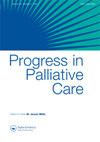晚期非小细胞肺癌患者姑息治疗转诊的时机:一项回顾性队列研究
IF 0.8
Q4 PUBLIC, ENVIRONMENTAL & OCCUPATIONAL HEALTH
引用次数: 0
摘要
简介:建议对癌症(NSCLC)IV期患者进行早期姑息治疗转诊,无论是否决定实施癌症导向治疗。诊断转诊和转诊至死亡间隔,作为衡量护理质量的指标,在中低收入环境中很少报道。目的:评估阿根廷一家教学医院IV期非小细胞肺癌患者6个月姑息治疗转诊的累计发生率和转诊至死亡间隔的时间。方法:对2012年至2017年间诊断为IV期NSCLC的患者进行随访,直至2019年12月。我们从集中的电子健康记录中检索到了与姑息治疗服务的第一次接触和死亡日期。姑息治疗转诊的累计发生率是通过拟合Fine&Gray竞争风险模型来估计的。结果:包括92例患者。中位年龄为71.5岁(IQR 63–79岁),55%为女性。中位生存时间为375天(95%可信区间:204–508天)。考虑到死亡是一种相互竞争的风险,姑息治疗转诊的6个月累计发生率为37%(95%置信区间:27%至47%)。在转诊患者中,转诊至死亡的中位间隔为31天。讨论:进一步的研究应侧重于识别和克服这一人群中及时转诊姑息治疗的障碍。本文章由计算机程序翻译,如有差异,请以英文原文为准。
Timing of palliative care referral in patients with advanced Non-Small Cell Lung Cancer: a retrospective cohort study
Introduction: Early palliative care referral is recommended for patients with Stage IV Non-Small Cell Lung Cancer (NSCLC) irrespective of the decision to administer cancer-directed therapies. Diagnosis-to-referral and referral-to-death intervals, proposed as measures of quality of care, are rarely reported in low-and-middle income settings. Objective: to estimate the 6-month cumulative incidence of palliative care referrals and the length of referral-to-death intervals among patients with Stage IV NSCLC at a teaching hospital in Argentina. Methods: Patients with Stage IV NSCLC diagnosed between 2012 and 2017 were followed up until December 2019. We retrieved the first contact with palliative care services and date of death from centralized Electronic Health Records. Cumulative incidence of palliative care referrals was estimated by fitting a Fine & Gray competing risks model. Results: Ninety-two patients were included. Median age was 71.5 years (IQR 63–79 years), 55% were women. Median survival time was 375 days (95% CI: 204–508 days). Considering death as a competing risk, the 6-month cumulative incidence of palliative care referrals was 37% (95% CI: 27% to 47%). Among referred patients, the median referral-to-death interval was 31 days. Discussion: Further research should focus on identifying and overcoming barriers to timely palliative care referrals in this population.
求助全文
通过发布文献求助,成功后即可免费获取论文全文。
去求助
来源期刊

PROGRESS IN PALLIATIVE CARE
PUBLIC, ENVIRONMENTAL & OCCUPATIONAL HEALTH-
CiteScore
2.60
自引率
11.80%
发文量
24
期刊介绍:
Progress in Palliative Care is a peer reviewed, multidisciplinary journal with an international perspective. It provides a central point of reference for all members of the palliative care community: medical consultants, nurses, hospital support teams, home care teams, hospice directors and administrators, pain centre staff, social workers, chaplains, counsellors, information staff, paramedical staff and self-help groups. The emphasis of the journal is on the rapid exchange of information amongst those working in palliative care. Progress in Palliative Care embraces all aspects of the management of the problems of end-stage disease.
 求助内容:
求助内容: 应助结果提醒方式:
应助结果提醒方式:


